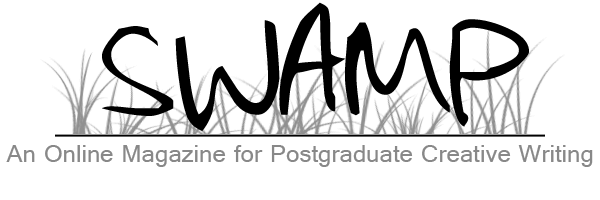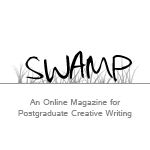Fabric of Change
Ola Kwintowski (University of The Sunshine Coast)
Jo, 2023
Jo fished out a black skirt from the box. Part of his job involved sorting what came into the op-shop. He ran his hand over the fabric. It was definitely silk. There was no instructional tag inside. Someone’s passion project? The hem was skilfully hand embroidered with tiny roses. However, at the base of the skirt, there was a crudely sewn-on pirate skull. On the underside of the garment it looked like someone had tried to cut through layers of intricate stitching, given up, then resorted to stitching a garish skull over the top. A strange juxtaposition of styles. It would have been a stunning piece originally, now the details were fading and the threads wearing thin. He placed it aside for later.
Many of the clothes that people dropped off were exhausted pieces – worn, stretched and stained – they had already lived their best lives but were great for repurposing. He’d made rugs from cotton t-shirts before and seen others make impressive patchwork quilts. Jo enjoyed digging for treasures, such as vintage Australian designs like Sparks and Zampatti, classic Levi jeans and the occasional Chanel shirts – he’d developed a knack for telling the fakes from the legit ones. Some days felt like he was traversing through a history of prestigious fashion, other times were horror shows, best left in the boxes, bundled or repurposed. It was the perfect part-time gig while he studied Fashion Design – so many hidden gems made their way into his crafty hands. But today marked his last day – tomorrow he’d be starting his internship, and that left little time for much else.
‘Hey, Mister,’ said a gruff voice.
Jo looked up at a man with a messy beard, a frayed beanie, worn skin and sunken eyes.
‘Morning, Ziggy.’
Ziggy’s face lit up at the note of recognition. His blue eyes lit into existence and all the wrinkles on his grey skin rose in unison with his gummy smile. Jo had not seen a more animated face than his – it twitched and moved as if following all the scattered and meandering thoughts inside. Jo would miss this place. He would miss the people. His adopted, strange and quirky family. Smelly family. But still family.
Ziggy placed a pair of black leather boots on the counter. They were in good nick. New, they’d be worth a few hundred bucks.
‘How much for these bad boys?’ he began taking out coins from his pocket. Bits of thread and random screws were pulled out onto the counter, along with a broken keychain, some plastic bread tags and a couple of safety pins.
Jo sorted through the stash. $2.25.
‘We have a special deal on these, Ziggstar: $1 per shoe.’
Ziggy contemplated the deal. He sniffed the shoe. Put his ear to it. His eyes darted to a stack of jumpers nearby.
‘What about them?’ he pointed to the pile.
‘They’re to go to the homeless shelter. If you take them for me, you can take one for free.’
‘I don’t need charity,’ said Ziggy, annoyed.
‘It’s not charity if you’re helping me out. But, if you insist, they’re fifty cents each.’
Ziggy pushed a few coins towards Jo and stuffed a mustard-coloured cardigan into his bulging hessian bag.
‘I’ll come back for the shoes, tomorra.’ He took the rest of the jumpers under his arm and walked out of the store. He packed the goods into his rickety shopping trolley and headed off.
Jo wouldn’t be back tomorrow. But he sucked at goodbyes.
The shift went by fast. At the end of the day, he grabbed the leather boots and locked up for the final time.
In preparation for his internship, Jo worked on his outfit. He wanted to make a statement, but not stand out too much. It needed to be both modern and comfortable. Simple elegance was key. He settled for a pair of grey tailored pants and a white button-up shirt. Sleeves rolled up. All he needed was a tie. He reached for the silk skirt.
After rolling the fabric out, he decided there was enough to make three different styles of neckties. He drew a pattern for an Ascot tie, a Windsor tie and, the one he would opt to wear, a skinny tie.
The remaining fabric went towards a shoeshine cloth. He pulled out the leather boots, cleaned them, polished them and buffed them with the silk– they looked almost new.
The next day Jo swung by the homeless shelter. He spied Ziggy’s trolley and popped the boots inside with a tag labelled: ‘Gift – not charity’.
*
Ida, 2010
The theme was nautical.
Ida had half a day to get her costume together. Her mother offered for her to rummage through their old boxes in the attic – everything was fair game.
There were suitcases upon suitcases, all covered in dust. Why does she keep this junk? An op-shop drop would be on the cards soon. She peeled through the neat piles of linen dresses, pleated skirts, a leather jacket and a collection of shoulder-padded cardigans. There must be something here I can repurpose. She was a master of innovation and patching. Self-proclaimed – but a master nonetheless.
A large down window let in a panel of light and illuminated Ida’s white bleached hair as she continued to rummage through various trunks and cases. Achoo! The specs of dust danced around her, creating a halo of glitter; she looked otherworldly amongst all the forgotten items. This would have been an epic bedroom as a teenager – sans dust and the musky mothball smell. But her father got dibs on the room. It was his studio where he would design and sew amazing creations – most of which never made the catwalk, but Ida had fun showing them off to her friends. Since her parents divorced, her mother had refused to have anything to do with the room. Now Ida got a glimpse of why. Each box contained a hint of their past together. A part of their history. Her father had cleared most of the good stuff – she should’ve gone to him for an outfit.
She reshuffled some suitcases and came across an oversized shoe box. Inside, there was a parcel wrapped in tissue paper and beneath it, a pair of red Doc Martens boots. Her size. Winning!
Ida unwrapped the paper. A large black silk shawl unravelled onto her lap. It cascaded down and glimmered in the light. Vibrant-coloured roses and petals were embroidered around the edges. It was beautiful.
She set to work.
Bandana top, matching skirt and red boots – she would be the spiciest pirate at the party.
*
Robert, 1980
Betty was late. Always was. But no matter. He didn’t mind. He liked waiting for her. It made seeing her all the more exciting. They were going shopping. For a dress. For her, obviously. It was their anniversary dinner and they’d managed to get a booking at a swanky restaurant by the water. They didn’t go out dining much, so they were going to ham it up. And why not? It’s nice to celebrate now and again. He might even pop the question. She was a great bird. They were happy. When he mentioned it to his mates, their reply was, ‘Why ruin a good thing?’ But they were just stirring. He couldn’t help being a romantic, not that he would ever admit to being one.
Robert sat on the ledge of a large store-front display window. He watched as the city folk scuttled across the mall pavement in all directions. Most of the women wore woollen jackets with raised shoulder pads and tailored pencil skirts. The men were in suits. A few holiday goers cruised around in their acid-washed denim. Robert preferred the classic style. Black on black. Can’t go wrong with that. Black jeans. Black t-shirt. Keep it simple. Keep it classy. Some school kids passed him; they’d thrown oversized neon shirts over their school uniforms and bum-puffed cigarettes as they laughed between coughing fits. Were they trying to stand out? Probs were. Why be a badass if no one notices? Right? He wasn’t sure if he wanted kids. They seemed like a lot of responsibility. He skimmed his ciggie butt towards the gutter.
Betty came into view. He saw people stare at her as she strode past confidently. Their jaws dropped in admiration. She spotted him and threw him a wink and smirk for good measure. She had on her fishnet stockings, a mini denim overall dress and her signature red Docs. It wasn’t so much what she wore, but how she wore it. She oozed sex appeal. Even though her dress was loose it managed to hug her curves, hinting at what lay beneath.
She just about knocked him over as she greeted him with a pash.
‘Been waiting long, Bobby?’ She ran her fingers through his hair and rested her palm behind his neck.
He pulled her into his lap and answered her with more kisses. It was enough to rouse the department clerk and shoo them away.
The shopping was a success. Betty found a little black slip. He was pleased with her choice as he had wanted to make her something for a while and had the perfect shawl in mind.
Robert carefully unpicked the fabric. The silk ran through his fingers. The embroidered flowers still perfectly preserved. He had seen a photograph of his mother, Prue, in this dress. She was young – at the start of her dressmaking career. The dress was a first of its kind and had placed his mother at the forefront of the fashion industry – a great feat for a woman in the 50s. The pride on her face said it all. She had passed on this passion for creating to him. Not that his father approved. Not that his father approved of much. He called what Prue did ‘men’s work’, and when Robert showed interest, he jeered him saying it was ‘women’s work’. Go figure.
*
Prue, 1945
She knew there was a lot at stake. It could go either way. Being a woman, meant stakes were generally higher – but Prue Sparks wasn’t afraid of chasing her dreams or taking chances. Despite her petite figure and softly spoken manner, she possessed a fiery determination – even if it meant side deals in Sydney’s back streets.
Prue, dressed in a thick woollen coat, readjusted the belt around her waist, pulled her collar up, exhaled a deep breath and stepped into the shadows onto the cobbled path that ran between two large buildings. It was a forgotten part of town, where the only passers-by were rubbish wrappers, empty beer bottles from lost, wandering drunks, and rats scampering around in gutters.
The door to the warehouse was small in comparison to the large frontage of the shed. She knocked slowly three times and waited. The soft sound of metal swooshing across the peephole sent a shiver down Prue’s neck. She heard the clanking of keys against the lock and the heavy door opened towards her.
Stood in the doorway, was a man in a tailored suit, and despite the time of evening, he wore a felt fedora. She could not see his face, for the light was behind him. He gestured her inside.
‘Miss Sparks, welcome,’ he said in a professional, but friendly tone.
She followed him in.
They had met earlier this month at a local charity event. Prue had been discussing how hard it was not to be able to source anything of value. He offered to help her. She had saved a month’s worth of pay. It was a gamble to trust a man she had only met once earlier, especially with the economy being as it was after the war. But here they were.
They walked across to a large metal table that shimmered under the downlights. The workspace was immaculate. He placed a large brown paper roll onto the table and carefully unwrapped it.
Black silk cascaded onto the table. It glistened and moved just like the surface of an ocean under moonlight.
Prue carefully unravelled the silk when she got home. Her workspace was set out with fabric shears, a pin cushion filled with pins and needles, new cotton and measuring tape. This outfit would be hand sewn – every stitch deliberate and calculated. She had salvaged an old mannequin from one of the large department stores where she worked, and with some careful crafting and adjusting, had managed to create a close representation of her size. She had set aside some left-over black brocade fabric from a previous project and French lace offcuts that she would dye black. She could only afford two metres of silk – but Prue did not see this as a setback, instead a challenge in innovation – she would experiment with texture and style. It could go either way.
The neckline dipped a touch and teased the edge of the shoulders while the sleeves sat snug on her arms before the cuffs flared out at the elbows. This would be a bold move, but an invitation to a fashion show at The Ambassadors’ Ballroom would include some of the most prestigious designers – this was the ultimate place to be a little bit risqué. The hemline fell below the knee as intended. From the back, the design resembled an elegant, tailored dress. At the front, a raised brocade panel extended from her waist down, inspired by natural landscape textures. The lace sat on top of the silk on the skirt and met the brocade art piece at the front. A layer of tulle beneath the dress allowed the silk to flow on top, while the lace sent shadows dancing over the top and produced an illusion of movement and texture.
Prue spent every evening over the next fortnight working on her masterpiece. She made sure each stitch was evenly spaced, secure and neat.
The finishing touches took the longest.
In exchange for butter and sugar, her neighbour had sourced spools of silk thread. A blend of reds, oranges, yellows and greens rolled onto her workbench. They were worth every drop of butter and cube of sugar.
Prue created a detailed pattern of tiny roses that dappled around the neckline, with delicate green leaves that fell into the brocade fabric. On the lace, she had sewn large roses with bulging petals where she built layers of stitches, creating intricate shades and tones. A mixture of crimson roses with touches of quinacridone gold and cadmium orange filled the dark canvas and erupted with life. Her fingers tips endured the most despite her best attempts at using the thimble. She didn’t mind, however. She enjoyed the process of feeling each fibre, guiding each thread. This was not just a dress. It was not just her work. It was who she was. A reflection of her passion. Her vision. Her heart on the outside.
Each stitch meticulous and filled with hope.
Ola recently completed an Honours degree in Creative Writing at the University of The Sunshine Coast, focusing on the profound connection between environmental narratives and sense of place. Currently, she is embarking on her PhD project, delving into the fascinating intersection of environmental writing and the creation of multimodal eco-novels through the incorporation of photography and illustrations to strengthen the relationship between literature, art and science to deepen connection and understanding.






